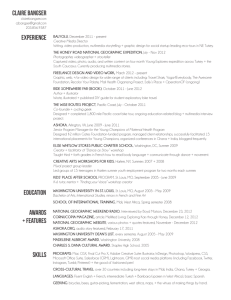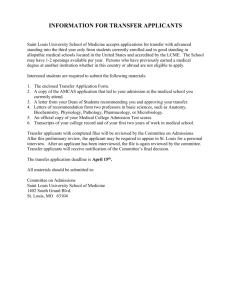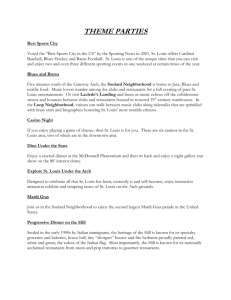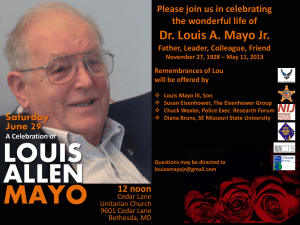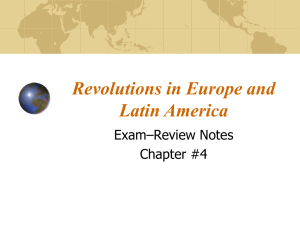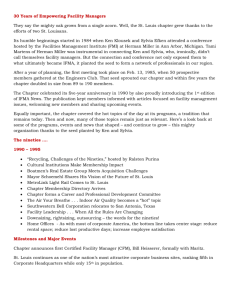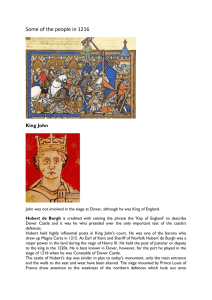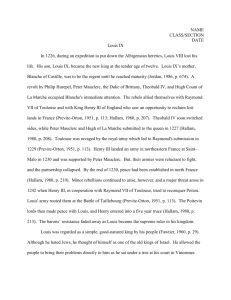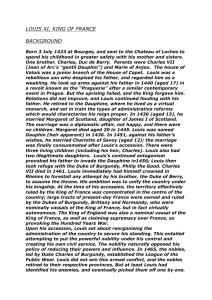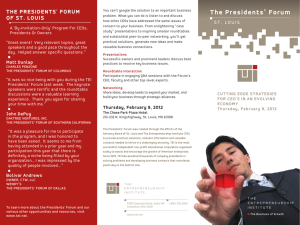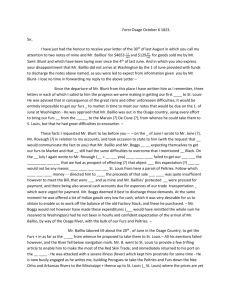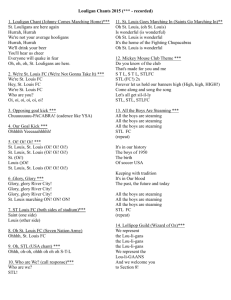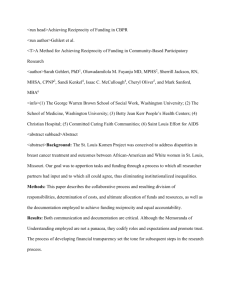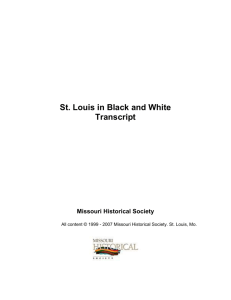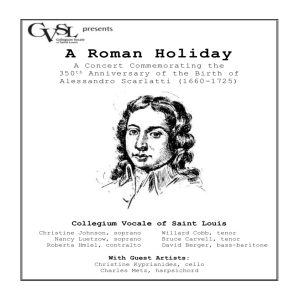CityArchRiver Campaign Trivia Game
advertisement
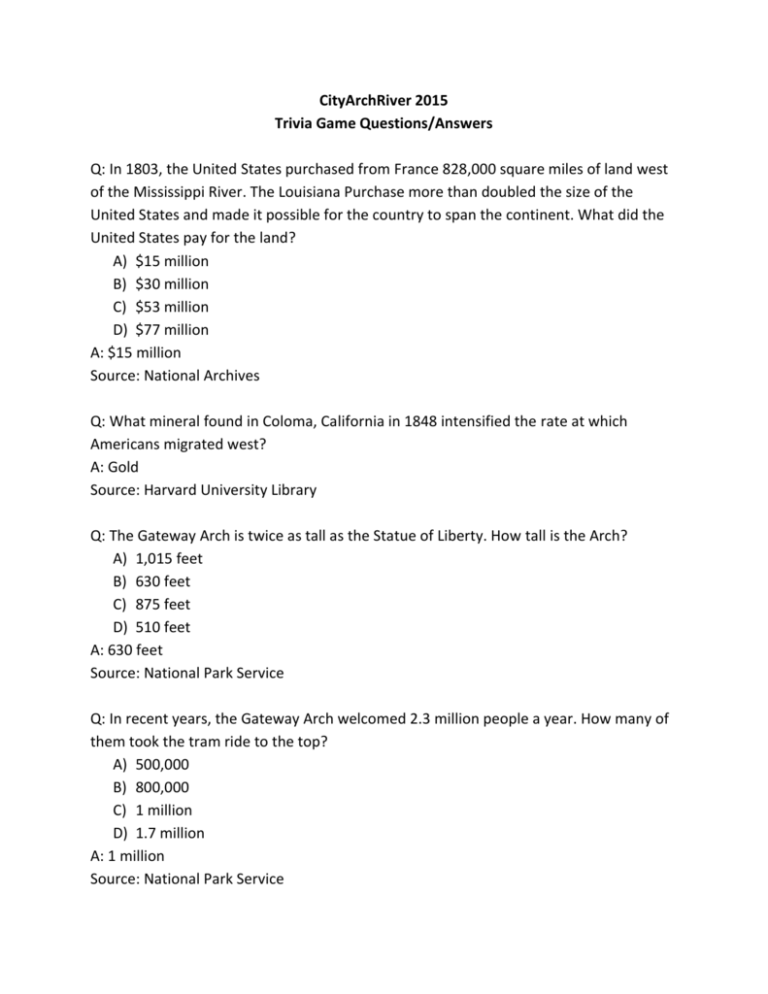
CityArchRiver 2015 Trivia Game Questions/Answers Q: In 1803, the United States purchased from France 828,000 square miles of land west of the Mississippi River. The Louisiana Purchase more than doubled the size of the United States and made it possible for the country to span the continent. What did the United States pay for the land? A) $15 million B) $30 million C) $53 million D) $77 million A: $15 million Source: National Archives Q: What mineral found in Coloma, California in 1848 intensified the rate at which Americans migrated west? A: Gold Source: Harvard University Library Q: The Gateway Arch is twice as tall as the Statue of Liberty. How tall is the Arch? A) 1,015 feet B) 630 feet C) 875 feet D) 510 feet A: 630 feet Source: National Park Service Q: In recent years, the Gateway Arch welcomed 2.3 million people a year. How many of them took the tram ride to the top? A) 500,000 B) 800,000 C) 1 million D) 1.7 million A: 1 million Source: National Park Service Q: Before St. Louis became the hub of a movement west, it was a village with a diverse population. Most of the village’s French-speaking residents arrived from: A) New Orleans B) Canada C) France D) England A: Canada Source: Bob Moore, National Park Service historian Q: Early emigrants on the Oregon Trail traveled 2,170 miles from Missouri to Oregon. Which present-day state was NOT part of the Oregon Trail? A) Nebraska B) Idaho C) Wyoming D) Colorado A: Colorado Source: University of Nebraska Q: The Lewis & Clark Expedition concluded on September 23, 1806, on the Mississippi River bank in St. Louis. This round trip to the Pacific coast took: A) 5 months and 10 days B) 20 months and 10 days C) 11 months and 10 days D) 28 months and 10 days A: 28 months and 10 days Source: National Geographic Q: An attorney from St. Louis conceived of the idea of a public memorial celebrating St. Louis’s role in westward expansion and the people who made it possible. He was relentless in his pursuit of it. Who was the attorney? A) Thomas Hart Benton B) Auguste Chouteau C) Luther Ely Smith D) Pierre Laclède A: Luther Ely Smith Source: National Park Service archives Q: When you’re 630 feet tall and light on top, you must be ready for a big wind. The Arch is built to withstand 150-mile-an-hour winds and sway how many inches? A) 9 B) 18 C) 24 D) 30 A: 18 inches Source: National Park Service Q: The Great Fire of 1849 devastated the Mississippi riverfront at St. Louis. It killed three people and destroyed 418 buildings along 15 blocks. How did the fire start? A) A mattress fire aboard a steamboat B) A smoldering pipe set too near a bookcase in a nearby office building C) Flammable freight, including hemp, tobacco and wood, stacked too near motorized equipment D) Arson A: A mattress fire Source: St. Louis Post-Dispatch archives Q: The Great Fire of 1849 wasn’t the only setback of that year. The city also lost 4,317 people to an epidemic of …. A) Tuberculosis B) Yellow fever C) Cholera D) Malaria A: Cholera Source: St. Louis Post-Dispatch archive Q: What mode of transportation emerged in the 19th century that lessened the role of river travel and accelerated the pace of developing the West? A: Rail/train/locomotive Q: A Native American woman joined the Lewis & Clark expedition and earned her place in history by, among other things, reaching into the river and saving precious journals and supplies when a gust of wind tipped the explorers’ vessel. Who was she? A) Pocahontas B) Sequoya C) Sacagawea D) Wilma Mankiller A: Sacagawea Source: National Geographic Q: Among historic cases argued in the Old Courthouse was a slave’s pursuit of the right to sue for his family’s freedom. Who was the plaintiff? A) William Tucker B) Tom Molineaux C) Eli Whitney D) Dred Scott A: Dred Scott Source: Cornell University Legal Information Institute Q: The Lewis & Clark expedition accelerated once it entered the westward-flowing waters of what river? A) Sioux B) Columbia C) Mackenzie D) Yellowstone A: Columbia Source: National Geographic Q: The road between the Mississippi River and the Gateway Arch is named after Leonor K. Sullivan, who was a: A) Wife of a steamboat magnate B) Heiress C) Congresswoman D) Local attorney and philanthropist A: Congresswoman Source: City of St. Louis


